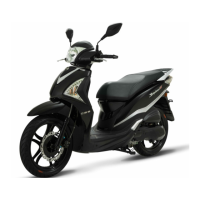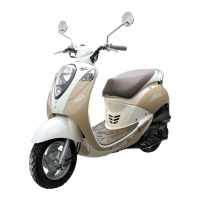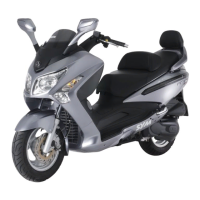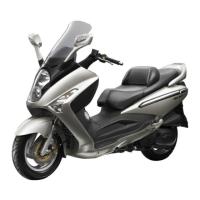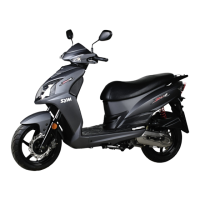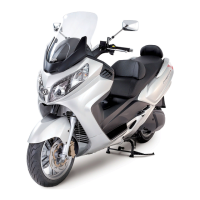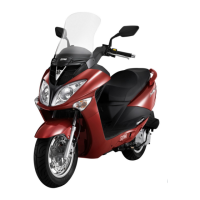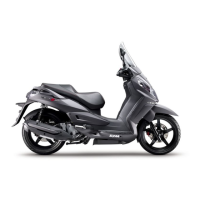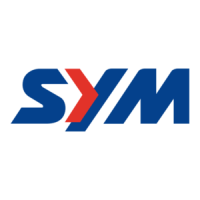
Do you have a question about the Sym XH12WW-EU Series and is the answer not in the manual?
Overview of dashboard indicators and their functions.
Displays driving speed or engine RPM. Indicates total accumulated distance traveled.
Measures trip kilometers. Allows switching between total distance and trip display.
Indicates when the high beam headlight is turned on.
Flashes to indicate the direction of the turn signal.
Shows the remaining fuel level in the tank.
Indicates engine cooling water temperature and fan motor status.
Displays average battery voltage or time.
Lights up if there is an issue with the ECU.
Indicates when it is time for an oil change.
Indicates the status of the Anti-lock Brake System.
Procedure for setting total mileage and oil mileage.
Procedure for setting the hour, minute (tens digit), and minute (units digit).
Engine can be started, key cannot be removed.
Engine is off, key can be removed.
Information on smart key operation and intelligent lock.
How to lock the steering handle using the ignition key.
Procedure to open the seat using the ignition key.
How to set acoustic-optic and silent alerts using the remote control.
Procedure to unlock and release the alert system.
Alert when the alarm is not set after 5 seconds.
Alarm triggered by force opening of switch lock while in anti-theft state.
Automatic locking of the knob lock after 1 second.
System protection against repeated unlock/lock operations.
How to suspend the alarm in vibration alarm state.
Triggers and responses for acoustic-optic and silent alarms.
Status indicators for fortification, relieve, main switch, and alarm.
Details electrical, mechanical, and performance parameters of the scooter.
Important safety and maintenance advice for using the scooter.
Operates the engine starter motor. Requires brake lever engagement.
Switch for toggling between high and low beam headlights.
Activates front and rear turn signal lights simultaneously.
Used to turn off the engine in emergencies or start it.
Activates high beam temporarily to warn other drivers.
Button under seat for engine start, requires ignition ON and brake.
Activates the horn when the ignition switch is in the ON position.
Controls left/right turn signal lights for lane changes.
Location, capacity, and precautions for using the under-saddle storage.
Location and use of the hook for securing a helmet.
Procedure for opening, closing, and refueling the fuel tank.
Operation of front, rear, and combined braking systems (CBS/ABS).
Using engine braking for deceleration and on slopes.
Key steps and safety precautions for starting the engine.
Procedure for safely starting and moving the scooter.
To increase speed by turning the throttle handle.
To decrease speed by returning the throttle handle.
Steps for approaching and preparing to park the scooter.
Steps for stopping the engine and parking securely.
Check items and key points for daily pre-ride checks.
Procedure to check engine oil level using the dipstick.
Schedule and procedure for changing engine oil and filter.
Procedure for cleaning the oil filter element.
Checking fuel gauge and ensuring correct fuel type for the scooter.
Procedure to check transmission oil level.
Procedure for draining and refilling transmission oil.
Checking brake lever and pedal free play for front and rear wheels.
Visual checks for disc brake lines, leakage, and damage.
Checking brake pad wear limit and replacement criteria.
Checking brake fluid level in the reservoir.
Steps for adding brake fluid to the master cylinder.
Checking and adjusting the throttle cable free play (2-6mm).
Maintenance of maintenance-free battery, checking terminals.
Procedure for cleaning battery terminals.
Checking tire pressure, condition, and tread wear indicator.
Checking front shock absorbers for damage and proper operation.
Procedure for checking, replacing, and precautions for fuses.
Verifying operation of turn signals and horn.
Verifying headlamp, rear lamp, and their brightness.
Verifying the operation of the brake light.
Inspecting fuel tank, carburetor, and hoses for leaks.
Checking pivot points for adequate lubrication.
Procedure for removing, cleaning, and gap adjustment of spark plugs.
Procedure for disassembling and cleaning the air cleaner element.
Troubleshooting steps for an engine that fails to start.
Recommended fuel type and octane, and adjustments for high altitude.
Recommended type of transmission oil for the scooter.
General safety advice for operating the scooter.
Avoiding sudden braking and sharp turns to prevent slips.
Advice for riding safely in rain and wet conditions.
Explanation of ABS function, characteristics, and limitations.
Procedure for checking the cooling system for leaks.
Procedure for adding coolant to the reserved tank.
Table showing anti-freeze percentages for different temperatures.
Schedule of maintenance tasks based on mileage and time intervals.
Detailed specifications for XH15WW-VNC/XH15WX-VNC models.
Detailed specifications for XH12WW-EU/XH12WX-EU models.
Detailed specifications for XH20W1-DZC/XH20W1-ZA models.
Detailed specifications for XH20W1-EGC model.




